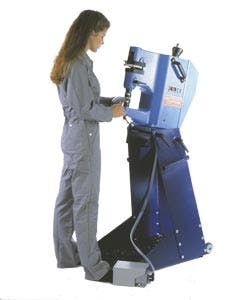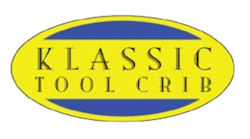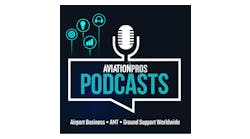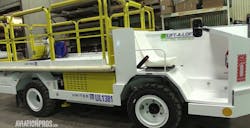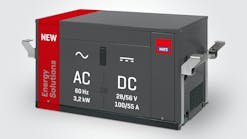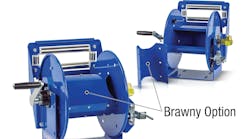Sheet metal tools are among the most commonly used tools in an aircraft technician’s tool chest. They are so frequently employed, in fact, that it is possible to take them for granted — especially when it comes to exploiting their full range of capabilities.
To clarify these capabilities, AMT magazine has brought in two experts.
They are George Messner, general manager of Klassic Tool Crib (www.klassictoolcrib.com), and Phil Adams, technician with Pan American Tool Corporation (www.panamericantool.com).
AMT: Let’s start by defining terms. When we talk ‘aircraft sheet metal tools,’ what tools are we commonly referring to?
Messner: When I speak of sheet metal tools, I would normally talk about anything that cuts, drills, bends, or shapes sheet metal.
Adams: Most would be referring to pneumatic air tools.
Messner: Tools for shrinking and stretching are very important, as well as tools to assemble the project. There is also a very wide range of finishing products available for polishing.
AMT: What tools are the most popular for sheet metal work, and why?
Messner: Some of the most popular tools are those that are safe to work with, ergonomically designed, and perform the task with the least amount of effort. They would certainly include edge deburring tools, recoilless riveting hammers, and ergonomically designed drills.
Adams: The most popular would be both angle and compact pistol grip drills. These are the most commonly used tools. They provide the mechanics with the ability to create the holes in the metal which would be followed with a Cleco fastener, a temporary fastener for assisting in the proper alignment of two pieces of metal.
Messner: A high-quality sheet metal shrinker and stretcher, like the Eckold brand, is worth its weight in gold when it comes to the ease of operation, time saved, and the finished results. Our new tungsten bucking bars are a huge improvement over the standard cast, forged, or machined steel bars. The weight of these bars is so much greater than the others, allowing them to absorb the constant blows produced during the rivet hammering process. The mechanics love them, as do the plant safety and health departments.
AMT: What distinguishes a great tool from an average one?
Adams: There are basically three grades of tools in the market. The first are Homeowners’ grade. Such a tool can handle light use, but does not have the ability to hold close tolerances when drilling.
The second is what is called Automotive grade. This is light use tooling with the ability to hold some close tolerances, but the materials used are designed for shortened life and would not be recommended for heavy use.
The third is Aerospace or Pro grade tooling. These are tools that allow the user to drill within close tolerances and give them the ability to do so for an extended period of time. In making these tools, close attention is paid to the type of materials used in the assembly of the tooling and the precision machining of said parts. At Pan American Tool we machine our housings from one solid bar of aluminum for proper motor alignment.
Messner: In my opinion, a great tool is one that is well-designed, can be used for a variety of tasks, and makes each task easier to accomplish. That could be a tool that has optional accessories available or comes in a kit form. Ease of maintenance and the availability of replacement parts, if or when needed, is also very important.
AMT: What tools are underrated for sheet metal work?
Messner: There are so many underrated sheet metal tools out there, including items like a simple Cleco, a side grip fastener, drill stops, hole finders, rivet and screw removal tools, and deburring tools. Larger ones that are often missed include multi-task sheet metal brakes, beading tools, and shrinkers and stretchers. Some of these items are very inexpensive, so there are few excuses not to have and use them. Others cost more, but in a shop environment, they can save time and money while producing a better product.
Adams: Pan American Tool offers a double margin drill bit that, if used in place of a standard jobber drill bit, can improve the quality of the hole by 50 to 60 percent. As well, these bits eliminate the need for reaming in most applications.
AMT: What is the most common mistake made in the handling of sheet metal tools?
Messner: In my opinion, I think it’s foolish to handle sheet metal without gloves or without first deburring the edges. The edges of the piece can be razor sharp and have been the cause of many trips to the hospital for stitches. Although gloves and deburring won’t eliminate all those accidents, it will sure help. A simple, cheap deburring tool is all you need to take the edge off. It only takes a second or two to be safe.
Adams: Knowing the materials you are drilling and using proper feed and speed to lengthen the life of the cutting tool. The rule of thumb is the harder the material, the slower the speed and the higher the feed rate. Be sure to check metal cutting handbooks for exact speed and feed rates.
Messner: It’s also important to have a large, clean bench to work on. Keep your sheet metal clean and free of scratches or nicks and bends. Have a safe, protected place to store it flat until you’re ready to use it.
AMT: What are the most important things to know about the care of sheet metal tools?
Messner: Sheet metal tools are no different than any other tool when it comes to care and maintenance. Keeping them clean is a start. Be sure to lubricate or grease those that require it on a scheduled basis.
Adams: The maintenance such as oiling of pneumatic tools is very important in ensuring their longevity. Over-oiling can lead to premature failure, drastically shortening the life of all components in the motor housing. Not oiling prior to storage can cause rust to seize internal parts due to moisture in the compressed air system.
Messner: Sharpen or replace dull cutting tools like drill bits, shear and saw blades, countersink pilots, and aviation snips, just to name a few.
If you’re using air tools like drills or rivet hammers, be sure you have an inline lubricator, filter, and regulator. Nothing is worse than dirt or water getting into an air tool.
As well, be sure to wipe your tools down before putting them away for the day.
AMT: Finally, what advances has your company made in sheet metal tool design?
Adams: We implemented a drill system (Nova kit) with 16 interchangeable heads housed in a portable case for use in the field or in the hangar.
Messner: One of the hottest items we have been working on is our new tungsten bucking bars. The use of a tough grade tungsten allows us to make very high-quality bars to our own design or custom-made to our customers’ drawings. The repetitive hammering, and the resulting impact shock transmitted to an operator using a conventional bar, has been known to be a big contributor to technicians developing carpal tunnel syndrome. The tungsten bar absorbs much more of that shock, sets the rivet quicker, and helps reduce the chance of developing carpal tunnel. Once the mechanic has a chance to use these new bars, he’ll never want to use his old ones.
